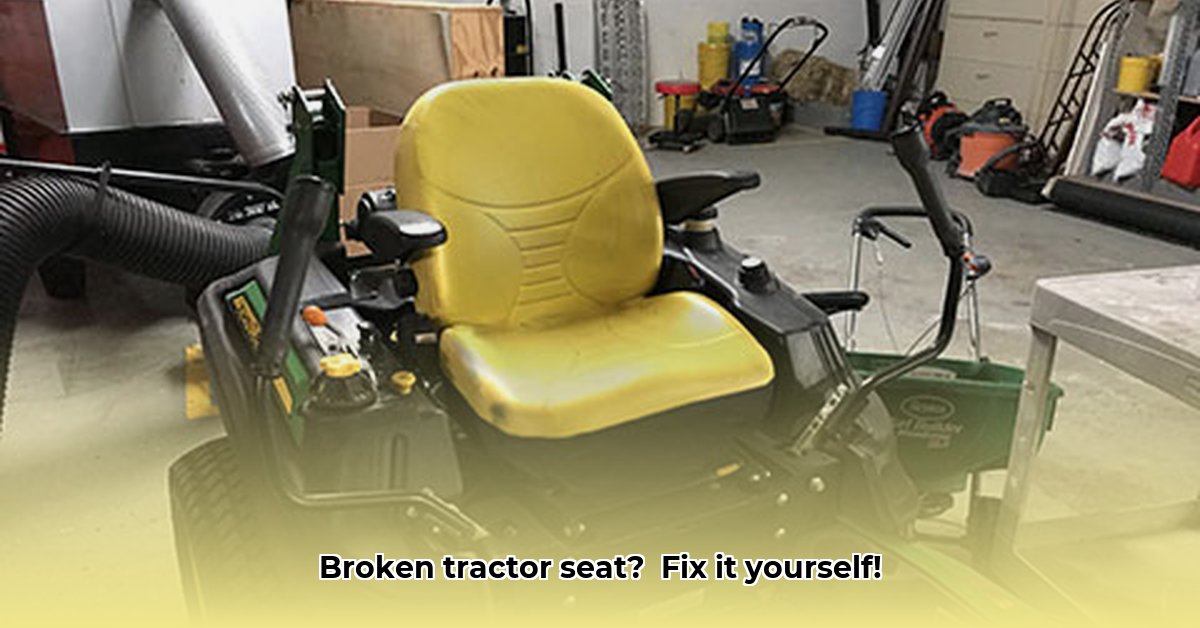
Tractor Seat Repair: A Cost-Effective and Sustainable Approach
High tractor repair costs significantly impact sustainable farming practices. Replacing a worn-out tractor seat, for instance, can be unexpectedly expensive. But what if a simple, cost-effective repair could extend the life of your equipment and significantly reduce waste? This comprehensive guide demonstrates how repairing your tractor seat is often a far more economical and environmentally responsible option than complete replacement. We'll guide you through the process step-by-step, offering valuable insights into cost savings, environmental benefits, and preventative maintenance strategies. Could you be saving hundreds, even thousands, of dollars each year by adopting a repair-centric approach? For more extensive replacement options, see John Deere seat replacement.
Assessing the Damage: Can Your Tractor Seat Be Repaired?
Before you dive into repairs, a thorough assessment is crucial. Determine if a repair is feasible or if replacement is necessary. This will influence your approach and save you unnecessary time and effort. Don't assume replacement is the only option!
1. Visual Inspection: Begin with a visual inspection of the seat's upholstery, suspension system (springs or air cylinders), adjustment mechanism, and mounting system. Look for tears, worn-out components, or signs of significant damage.
2. Problem Identification: Identify the specific issue. Is it a simple tear in the fabric? A broken adjustment lever? Or is the frame severely damaged? A precise diagnosis dictates the repair strategy.
3. Feasibility Determination: Honest self-assessment is key. If the damage is minor—a small tear, a stuck lever, or loose bolts—repair is highly likely. However, if the frame is severely corroded or damaged, replacement might be more cost-effective in the long run.
Tools and Materials: What You'll Need for Tractor Seat Repair
For most repairs, only basic tools are necessary. More complex repairs may require specialized equipment. However, many repairs are achievable with household tools, emphasizing the accessibility and affordability of this approach.
- Screwdrivers (Phillips and flathead)
- Wrenches (various sizes)
- Pliers (needle-nose pliers recommended)
- Upholstery repair kit (for patching or stitching)
- Lubricant (WD-40 or similar penetrating spray)
- Cleaning supplies (soap and water, brush)
- New upholstery fabric (optional, for patching or full replacement)
- Safety Glasses
- Work Gloves
Step-by-Step Guide to Tractor Seat Repair
This section offers a step-by-step guide for common tractor seat repairs. Remember to prioritize safety by disconnecting the battery before working on any electrical components. Consult your tractor's manual for specific safety guidelines. Always wear appropriate safety gear.
1. Upholstery Repair: For small tears, use an upholstery repair kit. Clean the area, apply the patching material, and let it dry completely following manufacturer’s instructions. For larger tears, replacing the upholstery panel might be necessary.
2. Suspension System Repair: If springs or air cylinders are damaged, carefully assess the extent of the damage. Replacement might be required, potentially necessitating specialized tools.
3. Adjustment Mechanism Repair: If the adjustment mechanism is jammed, carefully disassemble it (taking photos as you go), clean and lubricate moving parts, and reassemble. If parts are broken, replacement is necessary.
Preventative Maintenance: Prolonging the Life of Your Tractor Seat
Regular preventative maintenance reduces the likelihood of costly repairs. This proactive strategy minimizes downtime and maximizes equipment longevity. By regularly inspecting and servicing the seat, you increase its service life significantly.
- Regular inspections (monthly or quarterly, depending on usage)
- Cleaning and lubrication of moving parts
- Immediate attention to minor issues before they escalate
- Proper storage during periods of inactivity
Repair vs. Replacement: A Cost-Comparative Analysis
While exact costs vary depending on the repair and replacement parts, a general comparison illustrates the substantial savings afforded by repair. This analysis highlights a crucial aspect: repair is often significantly more economical than replacement. The table below provides a clear picture.
| Item | Repair Cost (Estimate) | Replacement Cost (Estimate) |
|---|---|---|
| Upholstery Repair | $25 - $100 | $150 - $400 |
| Suspension Repair | $50 - $200 | $200 - $700 |
| Adjustment Repair | $25 - $75 | $100 - $300 |
These estimates assume that you can repair things yourself. Hiring a professional will increase the cost of both repair and replacement options.
Beyond Seat Repair: A Broader Approach to Sustainable Agriculture
Beyond the immediate financial benefits, repairing your tractor seat promotes sustainable farming practices by reducing waste and minimizing the environmental impact of disposal. This aligns with broader sustainability initiatives and enhances the long-term viability of your farm. Consider this a step towards a more responsible form of farming.
This approach to tractor seat repair represents a broader commitment to sustainable agriculture practices. By prioritizing repair, and implementing regular maintenance schedules, you contribute to the longevity of your equipment, reduce overall costs, and minimize waste, ultimately promoting environmentally responsible farming operations. Remember, a well-maintained tractor contributes to a more sustainable and profitable farm.